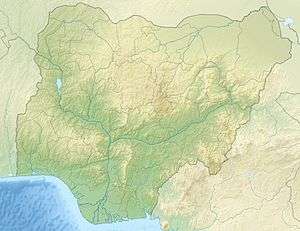Erinle River
| Erinle River | |
|---|---|
 | |
| Country | Nigeria |
| Location | Osun State |
| Physical characteristics | |
| River mouth |
Ede 7°45′16″N 4°27′00″E / 7.754543°N 4.450087°ECoordinates: 7°45′16″N 4°27′00″E / 7.754543°N 4.450087°E |
| Basin features | |
| River system | Osun River |
| Tributaries |
|
The Erinle River is a river in Osun State, Nigeria, a right tributary of the Osun River, which it enters from the north near Ede just below the Ede Dam. Another reservoir, the new Erinle Dam, lies higher up the river. Water from the two dams supplies Osogbo, the state capital. There are significant health issues with the untreated and treated water.
Name
In the Yoruba tradition, Erinle was a great hunter who became an orisha. He is said to have conducted the first Olobu of Ilobu to the site of the town of Ilobu, and to have protected the people of the town from Fulani invasions.[1] He is usually described as a hunter but sometimes as a herbalist or a farmer. It is said that one day he sank into the earth near Ilobu and became a river. He is known all over Yorùbáland.[2] The cult of Erinle is found in towns throughout the former Oyo Empire. His shrines contain smooth, round stones from the Erinle River. [1] The name may be derived from erin (elephant) and ilẹ (earth), or from erin and ile (house).[2]
Course
The Erinle River rises just south of Offa. It and the Oba River which rises about 15 kilometres (9 mi) north of Ogbomosho, are the main tributaries of the Osun River. The Erinle River has residential, commercial and industrial areas on both sides, which as of 2012 released untreated waste into the river. It was also polluted by excess fertilizers and pesticides from farmland.[3] The old and new dams on the river supply water to Osogbo, the state capital, which also uses boreholes and wells to obtain water.[4] Malaria and diarrhea are rampant in Osogbo, particularly in the high-density residential areas where the people depend on public tap water.[5]
Dams
The old Erinle dam was completed in 1954, with a reservoir capacity of 5,300,000 cubic metres (190,000,000 cu ft).[6] It is located in Ede town.[7] Tests in June and July 2011 showed that treated water from the dam had a high presence of total coliform and was not suitable for drinking without further treatment.[8] Bacteria in the treated water were also highly resistant to commonly used antibiotics in Nigeria.[9]
The new Erinle Dam in the Olorunda LGA lies upstream from the old Ede Dam on the Erinle River. It is owned and operated by the Osun State Water Corporation. The Otin River enters the dam from the left.[10] The reservoir behind the Ede-Ernle dam extends about 12 kilometres (7 mi) north along the Ernle River and covers the lowest portion of the Otin River.[11] The Erinle Dam, completed in 1989, is 330 metres (1,080 ft) above sea level. The crest length is 677 metres (2,221 ft) and maximum height is 27 metres (89 ft). The total storage capacity is 94,000,000 cubic metres (3.3×109 cu ft). The spillway discharges at 800 cubic metres (28,000 cu ft) per second. The dam is used for water supply, flood control and fishing.[10] Schistosomiasis, both urinary and intestinal, was reported downstream from the dam in 1991. A study in 2000–01 found that the prevalence of the host snails and of human infection had increased significantly since then.[12]
References
- 1 2 Drewal et al. 1989, p. 167.
- 1 2 Witte 1982, p. 161.
- ↑ Oyebanjo, Joshua & Jibiri 2012, p. 2.
- ↑ Fadare & Olawuni 2008, p. 37.
- ↑ Fadare & Olawuni 2008, p. 40.
- ↑ Oladejo 2014, p. 15.
- ↑ Timi & Adeniyi 2013, p. 1099.
- ↑ Timi & Adeniyi 2013, p. 1107.
- ↑ Timi & Adeniyi 2013, p. 1108.
- 1 2 Oladejo & Ofoezie 2006, p. 844.
- ↑ Adediji & Ajibade 2008, p. 111.
- ↑ Oladejo & Ofoezie 2006, p. 843.
Sources
- Drewal, Henry John; Pemberton, John; Abiodun, Rowland; Wardwell, Allen (1989). Yoruba: nine centuries of African art and thought (PDF). Center for African Art in Association with H.N. Abrams. ISBN 978-0-8109-1794-1. Retrieved 2014-08-21.
- Fadare, S.O.; Olawuni, P.O. (June 2008). "Domestic Water Supply and Health of Households in the Three Residential Densities in Osogbo, Osun State, Nigeria". Ethiopian Journal of Environmental Studies and Management. 1 (2). Retrieved 2014-08-21.
- Oladejo, S.O.; Ofoezie, I.E. (June 2006). "Unabated schistosomiasis transmission in Erinle River Dam, Osun State, Nigeria: evidence of neglect of environmental effects of development projects". Tropical Medicine and International Health. 11 (6): 843–850. doi:10.1111/j.1365-3156.2006.01628.x. Retrieved 2014-08-21.
- Oladejo, O.S. (March 2014). "MATERIAL PROPERTIES AS A MEASURE OF THE AGING EFFECTS OF EMBANKMENT DAMS" (PDF). International Journal of Engineering and Advanced Technology Studies. European Centre for Research Training and Development UK. 2 (1). Retrieved 2014-08-21.
- Timi, Adesoji A.; Adeniyi, Ogunjobi A. (2013). "Physicochemical Properties and Occurrence of Antibiotic-Resistant Bacteria in Ife and Ede Water Distribution Systems of Southwestern Nigeria" (PDF). World Applied Sciences Journal. Publications. 27 (9). ISSN 1818-4952. Retrieved 2014-08-21.
- Witte, H. (1982). "Mud-fish symbolism in Yoruba iconography". Commemorative Figures. Brill Archive. ISBN 90-04-06779-5. Retrieved 2014-08-21.